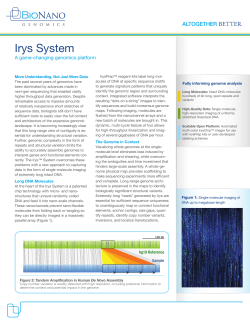
The Power Decoder Simulator - Poster
The Power Decoder simulator for the evaluation of pooled shRNA screen performance Jesse Stombaugh, Abel Licon, Žaklina Strezoska, Joshua Stahl, Sarah Bael Anderson, Michael Banos, Anja van Brabant Smith, Amanda Birmingham, Annaleen Vermeulen Dharmacon, now part of GE Healthcare, 2650 Crescent Drive, Suite #100, Lafayette, CO 80026, USA Summary of actual screen data analysis Power (%) Specificity (%) False Positive Rate (%) False Negative Rate (%) Experiment Average σ Average σ Average σ Average σ Screen 100_2x 27.60 0.45 98.95 0.01 1.05 0.01 72.40 0.45 Screen 100_4x 76.10 0.55 98.68 0.01 1.32 0.01 23.90 0.55 Screen 500_1.5x 58.35 0.92 98.95 0.02 1.05 0.02 41.65 0.92 Screen 500_2x 93.26 0.39 98.60 0.01 1.40 0.01 6.74 0.39 B Replicate 2 Normalized Counts RNA interference (RNAi) screening using pooled, short hairpin (sh)RNA is a powerful, high-throughput tool for determining the biological relevance of genes for a phenotype. Assessing an shRNA pooled screen’s performance is difficult in practice; one can estimate the performance only by using reproducibility as a proxy for power or by employing a large number of validated positive and negative controls. Here, we develop an opensource software tool, the Power Decoder simulator, for generating shRNA pooled screening experiments in silico that can be used to estimate a screen’s statistical power. Using the negative binomial distribution, it models both the relative abundance of multiple shRNAs within a single screening replicate and the biological noise between replicates for each individual shRNA. We demonstrate that this simulator can successfully model the data from an actual laboratory experiment. We then use it to evaluate the effects of biological replicates and sequencing counts on the performance of a pooled screen, without the necessity of gathering additional data. The Power Decoder simulator is written in R and Python, and is available for download under the GNU General Public License v3.0. A Replicate 2 Normalized Counts Abstract Biological replicate noise generated by the model is comparable to actual biological replicate noise Replicate 1 Normalized Counts Power Decoder: Building a Statistical Model Actual (r = 0.96) Simulated (r = 0.96) Actual (r = 0.90) Simulated (r = 0.90) Replicate 1 Normalized Counts Figure 4. Simulated replicate noise compared to actual biological replicate noise. Comparison of replicate noise of representative examples of normalized actual (red) and simulated (blue) data for (A) Screen 100_2x and (B) Screen 500_2x. For each graph, the number of counts for each shRNA in biological replicate 1 is plotted as a function of the number of counts for the corresponding shRNA in biological replicate 2. Simulate pooled screening NGS data by modeling: 1.The number of shRNA alignments in T0 and T1 to determine relative shRNA abundance 2.The biological noise between replicates. Modeling T0 Alignment Counts T0* = NB [µ = (T0t), dispersion = ƒ (µ)] Pooled screening experiments with engineered depletion and enrichment of shRNAs Materials and methods HEK293T cells were transduced with three different shRNA pools 1:1:1 1 : 2 : 0.5 that were combined in one lentiviral pool at the level of high titer lentiviral particles: Decode Pooled Human GIPZ Kinase Library (Dharmacon, Cat #RHS6078) Deliver shRNAs to cells Deliver shRNAs to cells enrichment and depletion sets. gDNA was isolated from T0 and T1 samples and NGS libraries were Select cells with shRNA Select cells with shRNA prepared using Decode Indexing, PCR, and Sequencing primer kit (Dharmacon, Cat #PRM6178) Reference (T ) Experimental (T ) 2X following the Manufacturer’s instructions and run on Illumina HiSeq 2000 (1x50 base reads, an average of 54 million reads per lane Isolate gDNA were obtained). Perform PCR Perform NGS NGS reads were aligned using Perform hit analysis Bowtie (v0.12.7). Any shRNA with more than 50 perfect alignments Summary of screens was considered present in the NGS experiment. The differential Average Fold abundance analysis was performed Enrichment/ Independent Representation using DESeq (v1.10.1), which is an Experiment Depletion Integrations in PCR Magnitude per shRNA Amplification R (v2.15.3) package, part of the Bioconductor (v2.11.0) framework. Screen 100_2x 2 100 100 DESeq uses a model based on the negative binomial distribution to Screen 100_4x 4 100 100 estimate the significance of the Screen 500_1.5x 1.5 500 500 fold change. It also applies the Screen 500_2x 2 500 500 Benjamini-Hochberg multiple test correction to the reported p-values. Hits were classified as any clone that had a multiple-test corrected p-value of 0.05 or lower. T0*: simulated alignment counts in T0 A T0t: actual alignment counts in T0 NB: sampling using the negative binomial mode and the mean-dispersion relationship function Kinome pool: 4,675 shRNAs Hit pool 1: 480 shRNAs (up) Hit pool 2: 480 shRNAs (down) Mean of Normalized Counts KS-test: p-value = 4.3e-12(σ = 6.4e-11) D = 0.080 (σ = 0.0062) B Higher T1 Abundance Unchanged T1 Abundance Lower T1 Abundance Mean of Normalized Counts Mean of Normalized Counts Figure 5. Differential enrichment and depletion of shRNAs in simulated screens. MA plots for two representative examples of simulated data from shRNA pooled screens with in silico two-fold enrichment and depletion of shRNAs based on (A) Screen 100_2x and (B) Screen 500_2x. The shRNAs with significantly (p* ≤ 0.05) higher and lower abundance in T1 in the simulated NGS count data are in red and blue, respectively. Power values listed are mean +/- standard deviation over 900 simulations. Comparison of actual and simulated screen data analysis Experiment Number of Replicates Screen 100_2x Screen 100_4x Screen 500_1.5x Screen 500_2x 3 3 3 3 Mean of Normalized Counts Figure 2. Modeled NGS screen data compared to actual experimental NGS screen data. Kernel density estimate plots for the distributions of NGS counts for representative examples of normalized actual (red) and simulated (blue) T0 data generated by fitting parameters to the negative binomial distribution for Screen 500_2x (left). Cumulative distributions of the same actual and simulated T0 count distributions for Screen 500_2x (right). Actual Power (%) Average σ 27.60 0.45 76.10 0.55 58.35 0.92 93.26 0.39 Actual Specificity (%) Average σ 98.95 0.01 98.68 0.01 98.95 0.02 98.60 0.01 The mean-dispersion relationship of actual biological replicate noise for shRNAs in NGS data can be used to model biological noise B Higher T1 Abundance Unchanged T1 Abundance Lower T1 Abundance Mean of Normalized Counts Log2 Fold Change Log2 Fold Change Higher T1 Abundance Unchanged T1 Abundance Lower T1 Abundance Power = 27.60% (σ= 0.45) Mean of Normalized Counts Figure 3. The mean-dispersion relationship of actual biological replicate counts for shRNAs in NGS data. Mean-dispersion relationship for representative examples of normalized experimental data from Screen 500_2x. The dispersion parameter for each individual shRNA graphed as a function of mean number of counts for that shRNA. The red line is a regression line fitted through the points using the DESeq software, and can be used to model biological noise. Dispersion Estimate A Modeling T1 Alignment Counts Randomly select 20% of the shRNAs from modeled T0 data and apply fold change. To produce simulated alignment (T1*), replicates can be sampled using the mean-dispersion function from Figure 3. Power = 93.26% (σ= 0.39) Mean of Normalized Counts Figure 1. Differential enrichment and depletion of shRNAs in engineered screens. MA plots of representative examples of normalized data from experimental shRNA pooled screens with engineered two-fold enrichment and depletion of shRNAs where transductions were performed at (A) 100 and (B) 500 independent shRNA integrations on average. The shRNAs with significantly (p* ≤ 0.05) higher and lower abundance in T1 in the NGS count data are in red and blue, respectively. Power values listed are mean +/standard deviation over 30 normalizations. Simulated Simulated Power (%) Specificity (%) Average σ Average σ 30.43 1.97 99.66 0.1 84.37 1.25 99.15 0.15 63.19 1.75 99.33 0.14 95.52 0.67 99.00 0.16 Using the Power Decoder, screen sensitivity can be improved with additional biological replicates Figure 6. Power as a function of replicate number. Box plots represent powers derived from DESeq analysis of 900 simulated NGS experiments of Screen 100_2x per replicate level. For comparison, the actual power of the Screen 500_2x using two biological replicates is also plotted. 100 90 Screen 500_2x 80 70 60 50 40 30 Actual differential enrichment and depletion of shRNAs in engineered screens Higher T1 Abundance Unchanged T1 Abundance Lower T1 Abundance Power = 95.52% (σ= 0.67) Power = 30.43% (σ= 1.97) Power (%) 1 Fraction of shRNAs 0 Modeled NGS alignment data is similar to actual experimental NGS alignment data Fraction of shRNAs Kinome pool: 4,675 shRNAs Hit pool 1: 480 shRNAs Hit pool 2: 480 shRNAs Differential enrichment and depletion of shRNAs in simulator generated screens Log 2 Fold Change Results Log 2 Fold Change Use negative binomial distribution for simulating alignment data. Use R’s fitdistr function, determine the mean (µ) and dispersion parameters from the normalized means of the actual biological replicates from T0 data in Screen 100 and 500. T1* = NB [µ = (T0t *fold_change), dispersion = ƒ (µ)] T1*: simulated alignment counts in T1 Modeling Biological Replicates Knowing the relationship between the mean and the dispersion parameter of the negative binomial distribution, count data can be sampled to produce any number of replicates: 20 10 0 2 3 4 5 6 7 8 9 10 Number of Replicates Conclusion These investigations demonstrate how the Power Decoder simulator can help scientists plan future screens and easily investigate the likely effects of various experimental factors in silico, saving both time and money. Data from existing screens can also be analyzed retrospectively to evaluate their power and thus estimate the completeness of their resulting hit lists. Additionally, the Power Decoder simulator can be used to streamline optimization of novel pooled screening technologies such as gene knockout screens employing the new CRISPR (clustered regularly interspaced short palindrome repeats)associated nuclease Cas9. The ability to do fast, easy, accurate power analyses before screening will enable researchers to perform adequately powered experiments, thereby delivering reliable answers to crucial biological questions. gelifesciences.com/dharmacon ƒ(µi ) = dispersionParameterµ Where µi is the mean for an individual shRNA as determined from sampling from the count distribution model. TM
© Copyright 2025









